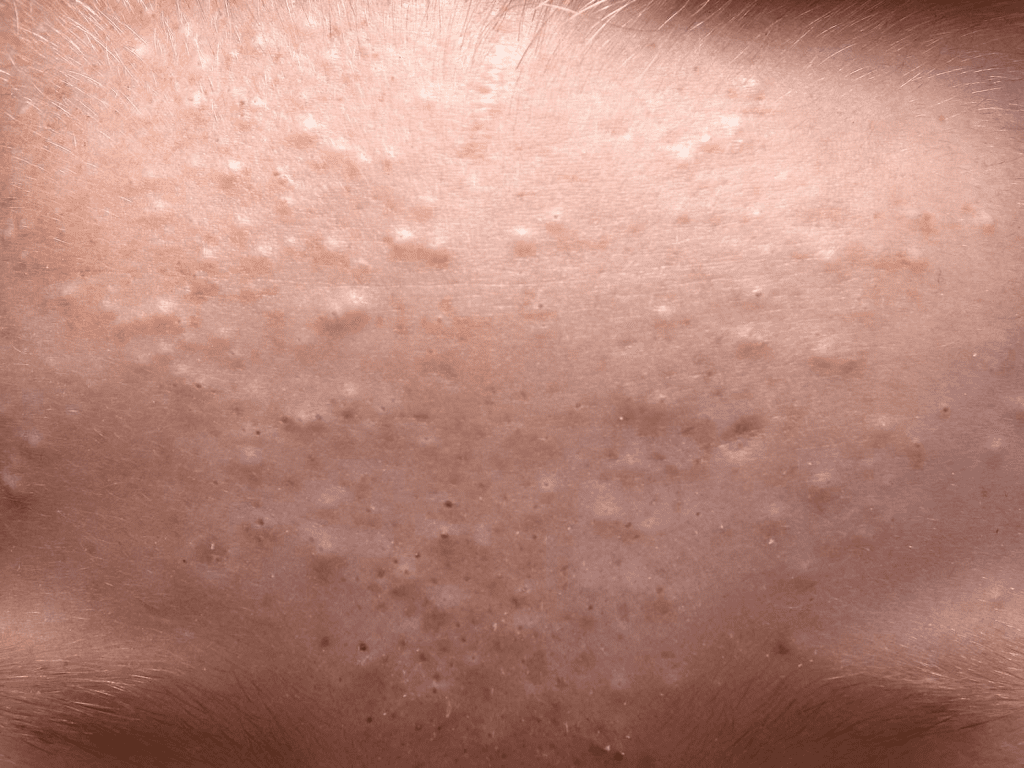Have you recently spotted tiny white bumps on your skin, particularly around your nose? You’re not alone. These small, often pesky bumps are a common skin issue for many people. While they can be a bit of a nuisance and not exactly the look you’re going for, the good news is they’re generally harmless. But what are these white bumps, and how can you get rid of them? Let’s dive in.
Understanding Those White Bumps

Those small white bumps you’re seeing are likely milia. Milia are tiny, keratin-filled cysts that develop just beneath the surface of the skin. They show up as small, white, or yellowish bumps and are often found on the nose, cheeks, and around the eyes. Unlike acne, milia don’t have an opening, making them tough to treat with typical acne products.
These bumps form when dead skin cells become trapped in small pockets on the skin’s surface, causing keratin (a protein found in skin, hair, and nails) to get stuck and form these cysts.
Should You Be Concerned About Milia?
1. Generally Harmless
First off, don’t panic if you notice milia. They’re typically benign and don’t pose any risk to your overall health. For most people, milia are more of a cosmetic issue than a medical concern. However, keep an eye on any changes. If the bumps start to swell, become painful, or turn red, it may be worth consulting a doctor to rule out other issues.
2. Persistent Little Things
One of the more frustrating aspects of milia is their persistence. Unlike pimples that disappear in a few days, milia can stick around for weeks, months, or even longer if untreated. But don’t worry, you can speed up their removal with the right approach.
3. Rarely Indicate Other Issues
While milia are usually harmless, a sudden widespread outbreak could signal an underlying health condition. If you notice a sudden outbreak or persistent milia, it’s a good idea to see a dermatologist to rule out any serious issues.
How to Get Rid of These White Bumps
Now that we know what these bumps are, let’s talk about how to get rid of them. There are several treatment options available, ranging from professional help to at-home remedies.
1. Professional Extraction
The most reliable way to remove milia is through professional extraction. Dermatologists have the right tools and expertise to safely remove these cysts without causing infection or scarring. Trying to pop milia at home is not advisable, as it can damage the skin or leave scars.
During a professional extraction, a dermatologist will use a sterile needle to create a tiny opening over the bump, allowing them to remove the trapped keratin safely. It’s quick, effective, and minimizes complications.

2. Prescription Retinoids
Another effective method involves using topical retinoids. These derivatives of vitamin A help promote cell turnover, keeping dead skin cells from clogging the surface. Prescription-strength retinoids can speed up the natural exfoliation process, helping the trapped keratin make its way out.
However, retinoids can be potent, so it’s important to consult a dermatologist before starting treatment. They’ll guide you on using the product without irritating your skin.
3. Over-the-Counter Exfoliants
For a gentler approach, over-the-counter exfoliants containing alpha hydroxy acids (AHAs) or beta hydroxy acids (BHAs) can help exfoliate your skin and prevent milia. Products with ingredients like glycolic acid or salicylic acid are effective at removing dead skin cells and promoting smoother skin.
Consistency is key here. Use these products regularly to prevent the build-up of dead skin cells that can lead to milia. Just remember to follow up with sunscreen, as exfoliating acids can make your skin more sensitive to the sun.
4. Home Remedies and DIY Solutions
If you prefer DIY skincare, some home remedies might help. Steaming your face can open your pores, making it easier for your skin to shed dead cells. You can also use gentle facial scrubs to exfoliate.
However, be cautious with at-home treatments. Over-scrubbing or using harsh ingredients can irritate your skin and make the problem worse. Always opt for gentle products and avoid anything that could further damage your skin barrier.
5. Avoid Heavy Creams and Oily Products

Preventing milia is just as important as treating them. One of the easiest ways to reduce your risk is to avoid heavy creams and oily skincare products that can clog your pores. Instead, choose non-comedogenic products designed to minimize pore blockage and keep your skin clear.
Also, be mindful of your makeup choices. Oil-based foundations and thick concealers can contribute to milia, especially if not thoroughly removed at the end of the day. Always double cleanse or use a makeup remover to ensure your skin is clean before bed.
Conclusion: Milia Are Manageable, No Need to Stress
Though those little white bumps on your nose and skin can be annoying, they are generally harmless and treatable. Milia are simply keratin-filled cysts that form when dead skin cells become trapped under your skin’s surface. With proper care, you can reduce their appearance and even prevent new ones from forming.
Whether you choose professional extraction, over-the-counter treatments, or simple skincare adjustments, consistency is key. If you’re ever unsure, consulting a dermatologist for personalized advice and treatment options is a good idea. Ultimately, clear, bump-free skin is within reach!